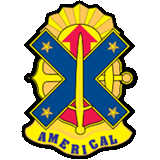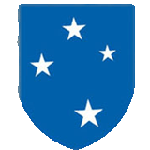

 |
The 23rd Infantry Division |  |
|---|
The 23rd Infantry Division, more commonly known as the Americal Division, was formed in May, 1942 on the island of New Caledonia. In the immediate emergency following Pearl Harbor, the United States had hurriedly sent three individual regiments to defend New Caledonia against a feared Japanese attack. They were the 132nd Infantry Regiment, formerly part of the 33rd Infantry Division of the Illinois National Guard, the 164th Infantry Regiment from North Dakota, and the 182nd Infantry Regiment from Massachusetts. This division was formed as one of only two un-numbered divisions to serve in the Army during World War II. After World War II the Americal Division was officially re-designated as the 23rd Infantry Division, however, it is rarely referred to as such. The division's name comes from a contraction of "American, New Caledonian Division". The Americal Division was involved in ground combat in both World War II and Vietnam.
The 164th Infantry Regiment of the Americal Division went into action on Guadalcanal on October 13, 1942 alongside the 1st Marine Division. It was the first United States Army unit to conduct an offensive operation against the enemy in either the Pacific or European Theaters of Operation (seven other U.S. Army divisions began offensive combat operations in late 1942. The Americal arrived piecemeal on the island, the 164th being first, was fed into combat alongside the battle-hardened Marines. The soldiers, benefitting from the combat experienced Marines, were able to learn jungle warfare opposing the Japanese without suffering as many casualties as they might have by coming into the combat alone and "green" like many units in the Pacific Theater were forced to do.
The Americal Division fought well at Guadalcanal as individual regiments. The 164th was involved in repulsing a major Japanese offensive in October, 1942, and the 132nd took Hill 27 and 31 and assaulted the highly fortified Japanese Gifu defensive complex at Mount Austen in January, 1943. The Americal Division was described as the most effective of all the US Army divisions on Guadalcanal. Elements of the Americal Division defended Henderson Field against heavy enemy attacks during October and, the following month, took part in the offensive across the Matanikau River. Following the withdrawal of the 1st Marine Division, the Americal participated in offensives to sweep Guadalcanal of remaining Japanese resistance. After the last Japanese defenders were killed, captured, or evacuated from the island, the Division was relieved on February 9, 1943.
The Division next moved to the Fiji Islands, beginning March 5, 1943, assuming the defense of the main island of Viti Levu and engaging in extensive training. On December 25, 1943, the Americal Division, alongside the 37th Infantry Division, a Marine defense battalion, and various supporting units, landed on Bougainville, the largest of the Soloman Islands. They were relieving the 3rd Marine Division and were given the task of holding and extending the right half of an established perimeter. The Division went on the offensive in March, 1944, driving the Japanese east of Mavavia River and seizing numerous strategic hill bases during the remainder of the month. Training and long-range patrol activity continued until November 30, 1944 when the Division was relieved.
On January 8, 1945, the Division began movement to the islands of Leyte and Samar, to take part in cleaning out remaining Japanese forces They also invaded the islands of Biri, Capul, Ticao, and Burias. Relieved from Leyte on March 13, 1945, the Division landed on Cebu, March 26th, and seized the city and airfield by March 28th. Divisional combat teams made landings on Bohol, Negros, and Mindanao, clearing out Japanese holdouts until June 17th. The division was then ordered to return for training for the proposed invasion of Japan. Because the Japanese surrendered on August 14, 1945, the division landed on Japan on September 10, 1945 and took part in the occupation of theYokohama, Yawasaki and Yokosuka areas.
The Division returned to United States on November 21, 1945, and was inactivated on December 12, 1945. The Americal Division was reactivated on December 1, 1954, as the 23rd Infantry Division, retaining the name "Americal" as part of its official designation, and served in the Panama Canal Zone until April, 1956, when it was again inactivated.
The Division was reactivated in 1967 in Vietnam. A division-sized task force known as "Task Force Oregon" was created in Quang Ngai and Quang Tin provinces with brigades from the 25th Infantry Division, 101st Airborne Division and the 196th Light Infantry Brigade, an independent brigade that deployed to Vietnam in 1966. The Americal's initial mission was to operate in close cooperation with the 1st Marine Division in the northern part of South Vietnam. As new U.S. brigades arrived in Vietnam, they were assigned to "Task Force Oregon", which was re-designated the 23rd Infantry Division (Americal). The Division was composed of the 11th, 196th, and 198th Light Infantry Brigades and divisional support units (see Americal Units).
The 198th and 11th Light Infantry Brigades were withdrawn from Vietnam in November, 1971, and the Division was inactivated. The 196th Brigade was reconstituted as a separate brigade and remained in Vietnam until June 29, 1972, the last major combat unit to be withdrawn. Its 3rd Battalion 21st infantry was the last U.S. maneuver battalion to leave Vietnam, on August 23, 1972.
The Americal Division fought "jungle" warfare throughout World War II and Vietnam. The Americal never lost a major battle in Vietnam, accounting for thousands of enemy dead and wounded, and is noted for its exemplary performance throughout its approximate 6 year deployment there. Americal casualties during WWII numbered 4,050 in 600 days of combat in the "Pacific Theater". Casualties in Vietnam numbered 4,041 (infantry brigades only) during 2,111 days of combat. American KIA's for the Americal infantry brigades in Vietnam were: 196th LIB (1,188), 11th LIB (1,109), 198th LIB (987), 199th LIB (757).
The following table lists the infantry battalions of the 23rd Infantry Division (Americal) for all ground combat operations conducted during the Vietnam War.
| Battalion | Division | Arrival | Departure | Duration | # Operations |
| 2/1 | 23 Infantry Division | 26 Aug 66 | 29 Jun 72 | 2135 days | 36 |
| 4/31 | 23 Infantry Division | 26 Aug 66 | 23 Oct 71 | 1887 days | 39 |
| 3/21 | 23 Infantry Division | 26 Aug 66 | 23 Aug 72 | 2190 days | 21 |
| 1S/1C | 23 Infantry Division | 29 Aug 67 | 10 May 72 | 1717 days | 15 |
| 2S/1C | 23 Infantry Division | 30 Aug 67 | 11 Oct 70 | 1139 days | 7 |
| 1/46 | 23 Infantry Division | 22 Oct 67 | 20 Jun 72 | 1704 days | 28 |
| 1/6 | 23 Infantry Division | 22 Oct 67 | 21 Nov 71 | 1492 | 9 |
| 1/20 | 23 Infantry Division | 18 Dec 67 | 30 Nov 71 | 1444 days | 15 |
| 3/1 | 23 Infnatry Division | 19 Dec 67 | 29 Oct 71 | 1411 days | 18 |
| 4/3 | 23 Infantry Division | 20 Dec 67 | 5 Nov 71 | 1417 days | 22 |
| 1/52 | 23 Infantry Division | 10 Feb 68 | 1 Nov 71 | 1361 days | 11 |
| 5/46 | 23 Infantry Division | 31 Mar 68 | 21 May 71 | 1147 days | 8 |
| 4/21 | 23 Infantry Division | 14 Apr 68 | 28 Jun 71 | 1171 days | 9 |
| References: |
|---|
| Wikipedia |
| World War II-Time Life Books |
| U.S. Army Center of Military History |
| The National Historical Society Publications |
| http://www.angelfire.com/al2/vietnamops/units |